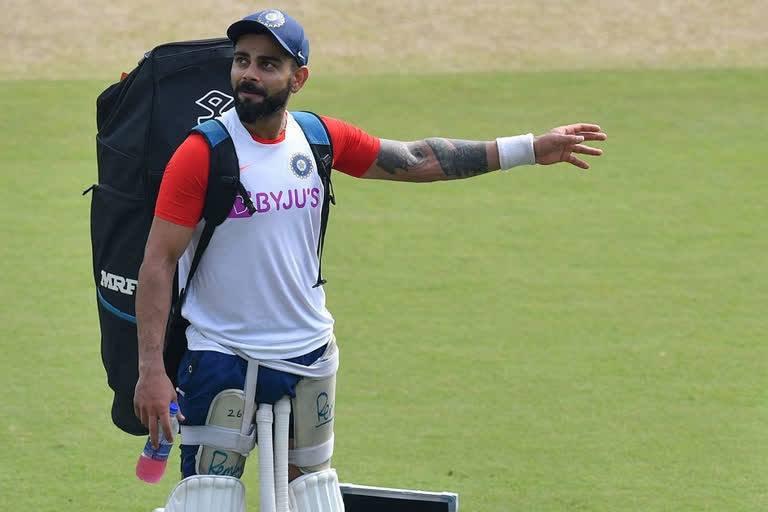New Delhi: Following the defeat in first Test in Chennai, the Indian cricket board has removed its curator who was to oversee the pitch preparation at the MA Chidambaram Stadium for the second Test, starting on Saturday.
Now, the Indian team management is overseeing the pitch preparation along with chief local groundsman V Ramesh Kumar, who hadn't prepared a pitch even for a first-class game before the first Test that India lost to England here on Tuesday. Now, Kumar has been assigned the crucial task of preparing the pitch, for which black soil will be used instead of red.
The gap between the first and the second Test, which is to begin on February 13, is only of three days. But the Board of Control for Cricket in India (BCCI) curator Taposh Chatterjee of Central Zone was sent off immediately after the first match and, instead, tasked to oversee the preparation of pitches for the Vijay Hazare Trophy matches in Indore and Jaipur.
The development is strange considering that the BCCI panel of curators, which was to be reviewed and revised at its annual general meeting in December, has four others besides Chatterjee in the elite panel. Ashish Bhowmick, who will prepare the Motera wicket for the third and fourth Tests against England, Prashanth K, Sunil Chauhan, and Prakash Adhav are the others. There were five other curators in the emerging panel earlier.
The Tamil Nadu Cricket Association (TNCA) confirmed the development.
"Taposh has left. He was there for the first match. V Ramesh Kumar will oversee the preparation for the second Test," TNCA secretary RS Ramaswamy told a news agency.
Read More | I was not sure if I wanted to play cricket again: Leach on Pant onslaught
Kumar is a businessman and had, in the past, not even prepared a first-class wicket.
"It is a surprise that no BCCI curator is at the spot as the BCCI sent back Taposh after the first Test when the players showed their displeasure with the way the pitch [for first Test] behaved on the first two days. The MA Chidambaram Stadium has not had a proper curator for a long time. Earlier, K Parthasarathy, the head groundsman, was looking after it, but he had not been a regular in the past few years," said a source close to the development.
"The wicket for the second Test is being prepared under the supervision of the team management. There has been no proper watering. The surface for the first Test had red soil and the pitch to be used for the second match is of black soil," he said.
Over the last 15 years, the Chennai pitch has attracted a lot of attention due to lack of grass and its weird behaviour due to a mixture of red and black soils. The pitch for the next game is also a mix, with its topping being of black soil while the one used for first Test was entirely of red soil.
"At other grounds like Bengaluru, Kolkata, or Mumbai, the grass recovers quickly. But not in Chennai nowadays. There are a combination of reasons for this. One is that there are far too many matches being played and the other is the Ranji Trophy team's demands. You would have noticed in the Indian Premier League also that chasing is always difficult here. There is no proper curator looking after it," he said.
The last Test held in Chennai prior to the just-concluded first Test was also against England, in 2016-17. That pitch was prepared by BCCI curator PR Viswanathan, who has since retired.
The ongoing Test series is happening during Covid-19 and there are back-to-back games at each venue, an unusual happening.
Experts believe that ideally the pitch (No. 2) for the first Test should have been used for the second and the one being used for second (No. 5) should have been used for the first.
"The reason is that the black soil retains water, so in the three-day gap before the second Test, only 10-20 litres water can be allowed at best. Otherwise, if you put more, the surface, due to heavy clay content, will retain water. If they had used pitch No.2, the red soil one, for this game instead, then you could have given more water in the three-day gap and it would have dried easily as that soil doesn't hold water. Now, due to dryness and no water, the black soil wicket can crumble early. It can also keep low," said an official.
Former head of BCCI pitches and grounds committee, Daljeet Singh, explained the characters of different pitches.
"I cannot comment on the Chennai pitch as I am not at the venue, if you mix soils it is difficult to predict a pitch's character. Black soil has more clay content, clay particle is the smallest in soil. The more the particles, the more water it will hold. But red soil has more silt and has more wear and tear as it gets dried and breaks easily for spin. It doesn't hold water," he said, explaining the science of pitch making.
Daljeet also praised the pitch for the first Test. "It lasted five days. That is what a Test match wicket is."



